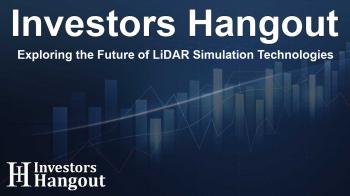Exploring the Future of LiDAR Simulation Technologies

Unveiling the LiDAR Simulation Market Growth
The global LiDAR simulation market is anticipated to reach a remarkable USD 4.01 billion in the near future, showcasing a substantial growth rate from USD 0.93 billion. This surge signifies a compound annual growth rate (CAGR) of 23.1%, reflecting the robust advancements in autonomous driving technologies today. With the demand for automotive LiDAR simulation on the rise, industry stakeholders are prioritizing thorough validation to ensure safety and reliability in advanced driving systems.
The Impact of Autonomous Vehicles
The strong momentum behind autonomous driving is significantly impacting the LiDAR simulation sector. Key regulatory frameworks necessitating precise environmental mapping, such as UNECE R157 and various standards in China, are pushing for high-resolution object detection technologies. Simulation tools are promptly emerging as essential components in this evolving landscape. Tools like Kevsight's LTS and StudioViz are designed not only to replicate real-world environments but do so cost-effectively while accelerating development timelines, particularly as original equipment manufacturers (OEMs) increasingly incorporate LiDAR technology into their vehicles.
Challenges Ahead
Despite the promising growth, challenges exist. The costs associated with LiDAR technology and its simulation are substantial, with concerns particularly pertinent to budget vehicles. Moreover, the high stakes of achieving reliable performance under varied conditions are driving a high demand for dynamic testing. As the industry grapples with these complexities, balancing sensor fusion and all-weather capabilities remains a critical challenge.
Solid-State LiDAR: Leading the Charge
The solid-state LiDAR segment stands out as a robust player in this market. Respected for its compatibility with modern vehicle designs, this type of LiDAR technology provides a smaller footprint and lower power consumption, making it ideal for electric vehicles. As highlighted in recent analyses, solid-state LiDAR's pricing ranges from USD 600 to USD 750 per sensor for mid-tier applications, expanding its appeal. The rapid scanning abilities and precise 3D mapping offered by solid-state systems are essential for real-time perceptions within autonomous vehicles.
Potential vs. Limitations
While there are significant advantages to solid-state LiDAR, challenges persist, such as difficulties in field of view and point density that may complicate large-scale adoption. Though touted for its durability, real-world scenarios often demonstrate issues such as thermal challenges in extreme climates, raising doubts about its adaptability in diverse weather conditions.
The Role of Testing Methods
As the market evolves, the demand for effective LiDAR testing methods is on the rise. The requirement for real-world validation becomes crucial in ensuring the authenticity and accuracy of LiDAR systems in varied environments—stress-testing across rain, fog, or urban complexity is paramount. Successfully meeting stringent safety standards, such as those set by Euro NCAP, calls for comprehensive sensor evaluations in real-world conditions.
Physical Testing versus Simulation
Although real-world assessments are vital for accurate validation, they carry inherent costs and logistical challenges. Complications like unpredictable weather conditions and access restrictions can hamper expansive field testing, especially in emerging markets where simulation can bridge these gaps. Ultimately, a hybrid approach that combines both real-world testing and sophisticated simulation will be critical for the advancement of safe and reliable autonomous driving technologies.
Regional Insights: Underlying Market Dynamics
As the landscape develops, North America is positioned as a significant player in the LiDAR market. The region is seeing compelling shifts towards higher autonomy levels, with vehicles utilizing advancements such as forward collision warning and automatic emergency braking systems. The integration of solid-state LiDAR is gaining traction in premium driver assistance programs, bolstered by influential activities in autonomous testbeds.
Emerging Industry Leaders
A variety of companies are leading innovations within the LiDAR simulation domain. Key players include reputable firms such as Dekra and Luminar Technologies, who are at the forefront of developing cutting-edge simulation technologies. The competitive landscape is marked by ongoing enhancements in products and services tailored to meet the increasing demand for LiDAR solutions.
Frequently Asked Questions
What is LiDAR simulation technology?
LiDAR simulation technology is used to create realistic models for testing autonomous vehicle sensors, allowing for detailed environmental mapping.
How fast is the LiDAR simulation market expected to grow?
The LiDAR simulation market is projected to reach USD 4.01 billion by 2032, growing at a CAGR of 23.1% from 2025.
What are solid-state LiDAR sensors?
Solid-state LiDAR sensors are compact, low-power devices used in autonomous vehicles for high-resolution 3D mapping and environmental detection.
What are the key advantages of solid-state LiDAR?
They offer benefits like smaller size, lower costs, rapid scanning capabilities, and high durability, essential for effective real-time perception.
What role does regulatory compliance play in LiDAR development?
Regulatory compliance ensures safety standards and facilitates the adoption of advanced technologies in the LiDAR simulation market, driving innovation.
About The Author
Contact Dylan Bailey privately here. Or send an email with ATTN: Dylan Bailey as the subject to contact@investorshangout.com.
About Investors Hangout
Investors Hangout is a leading online stock forum for financial discussion and learning, offering a wide range of free tools and resources. It draws in traders of all levels, who exchange market knowledge, investigate trading tactics, and keep an eye on industry developments in real time. Featuring financial articles, stock message boards, quotes, charts, company profiles, and live news updates. Through cooperative learning and a wealth of informational resources, it helps users from novices creating their first portfolios to experts honing their techniques. Join Investors Hangout today: https://investorshangout.com/
The content of this article is based on factual, publicly available information and does not represent legal, financial, or investment advice. Investors Hangout does not offer financial advice, and the author is not a licensed financial advisor. Consult a qualified advisor before making any financial or investment decisions based on this article. This article should not be considered advice to purchase, sell, or hold any securities or other investments. If any of the material provided here is inaccurate, please contact us for corrections.

